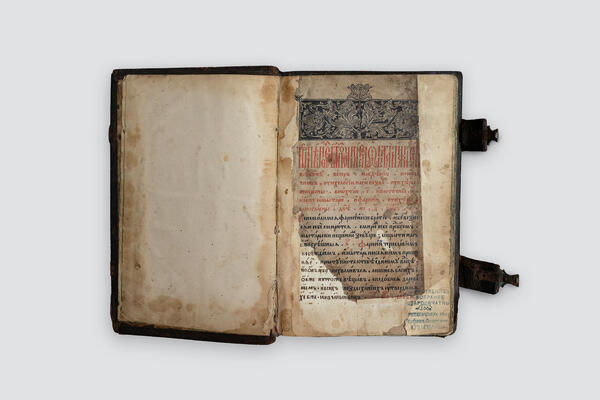One of the gems of the Penza Literature Museum’s exhibition is the Triodion, a liturgical book of the Orthodox Church, published in Moscow in 1607.
The Lenten Triodion contains three-song canons, hence its name. The book is written in Church Slavonic and astounds by its size and amazing binding. The item on display is one of folios. A folio is a book of the 15th–18th centuries, published by printing in a large format. Such folios could often weigh up to five or even seven kilograms. The Lenten Triodion in the museum’s exhibition is quite large: the book is about 7.5 centimeters thick, and it weighs almost three kilograms. The book is bound in full leather, with solid tooling on the covers and spine, with two metal locks.
The Triodion contains prayers for the days of Lent and Holy Week, beginning with the Sunday of the Publican and Pharisee and up to and including Great Saturday. It contains hymns composed mainly by authors of the 8th and 9th centuries, including Andrew of Crete, Cosmas of Maiuma, John Damascene, Emperor Leo the Wise, and Theophanes the Branded.
The book is ornamented with a decorative Cyrillic script (ligature), in which the letters converge, join one another, and are linked together continuously. The ligature was used in handwritten and early printed books, most often at the beginning of the text, and was usually made in cinnabar or other colored paint. For writing in ligature, the technique of letter reduction and its ornamentation was used. Thanks to the reduction, it was possible to place the number of letters necessary for a given text in the allocated space for decorative writing. Decorative initial capital letters were also often depicted in the form of animals intertwined with geometric patterns. Another significant element of book graphics was an ornamental thematic composition designed to emphasize or decorate the beginning of a chapter.
The book comes from the collection of old printed manuscript books of the Old Believer Stefan Fyodorovich Sevastyanov (1872–1944) and his son Mikhail (1928–2006), who lived in Rostov-on-Don. The Penza Literature Museum received the folio as part of the general set of books from the collection of the Alexander Radishchev Museum in 1984.


